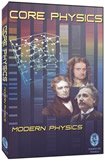Core Physics: Modern Physics

Price: $94.95


Product Feature
- Spanish & English subtitles
- Closed Caption
Product Description
Physics is the study of the elemental constituents of the universe. It deals with matter energy, forces, space and time. This program covers modern physics ... The period of time which brought us new paradigms of how the universe works and our place in it.Core Physics: Modern Physics Review
This film that can be viewed on any DVD player is really designed for a computer to be able to retrieve items like the timeline below.It is a cursive overview and even the most non-physics mind like those that read Gary Zukav can get an insight as to what physics really is and where we stand today (2007) that is. Math is very little to nil. Playtime about 30 minutes.
This is still a good addition to your library.
Core Physics: Modern Physics Timeline
1900 - Present
1901 - Max Planck makes his quantum hypothesis, called Planck's Law - energy is carried by indistinguishable units called quanta, rather than flowing in a pure continuum
1905 - Albert Einstein proposes Planck's quantum hypothesis as the physics underlying the photoelectric effect, developing quantum theory, one of the two most important developments in 20th century physics
1905 - Einstein publishes his Special Theory of Relativity
1915 - Emmy Noether publishes Noether's Theorem, discovering the relationship between symmetries and conserved currents that will later be crucial to the development of quantum gauge field theory and string theory
1915 - Einstein publishes his General Theory of Relativity
1924 - Louis duc de Broglie proposes the particle-wave duality of the electron in his doctoral thesis at the Sorbonne
1926 - Erwin Schrodinger develops his wave equation version of quantum mechanics
1927 - Werner Heisenberg discovers the Uncertainty Principle
1928 - Paul Dirac predicts the discovery of the positron
1929 - Edwin Hubble observes the redshift of distant galaxies and concludes that the
Universe is expanding
1931 - Einstein stops using the cosmological constant to keep the Universe from expanding.
1933 - Astrophysicist Fritz Zwicky infers existence of dark matter
1935 - Physicist Subramahnyan Chandrasekhar predicts black holes
1953 - Murray Gell-Mann lays foundation for the quark
1964 - Cambridge mathematician Roger Penrose proves that a black hole space/time must contain behind the black hole event horizon a singularity where space/time physics ceases to make good sense
1964 - Murray Gell-Mann proposes fundamental particles that Gell-Mann names "quarks"
1968 - Gabriele Veneziano founds modern string theory
1970 - Yoichiro Nambu, Leonard Susskind, and Holger Nielsen independently discover that the dual resonance model devised by Veneziano is based on the quantum mechanics of relativistic vibrating strings, and string theory begins
1973 - Predictions of Great Attractor are made
1974 - Stephen Hawking combines quantum field theory with classical general relativity and predicts that black holes radiate through particle emission
1974 - Joel Scherk and John Schwarz propose string theory as a theory of quantum gravity, an idea that takes ten years to be widely appreciated
1975 - Vera Rubin announces the existence of dark matter
1980 - Alan Guth puts forward the idea of an inflationary phase of the early Universe, before the Big Bang
1981 - Michael Green and John Schwarz develop superstring theory
1986 - Location of Great Attractor is found
2006 - Dark matter observed separate from ordinary matter
Most of the consumer Reviews tell that the "Core Physics: Modern Physics" are high quality item. You can read each testimony from consumers to find out cons and pros from Core Physics: Modern Physics ...

No comments:
Post a Comment